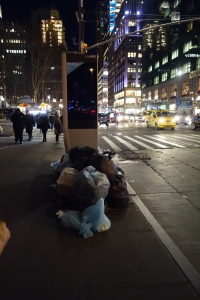I live in New York City, “city that never sleeps,” where you can get a manicure at 11pm, a haircut at 1am, and a slice of pizza at 3am. While it may be normal for people to be out and about at all hours of the day, I was surprised when I was walking home, late one night, and I came across two pigeons pecking at some garbage. It shocked me enough that I looked at my watch and noticed it was 12:30am. As I walked the remaining few blocks to my apartment I thought about this shift in animal behavior.
Pigeons shouldn’t be out at night. Wild rock pigeons (Columba livia) are found in cities around the world. They feed on grains and seeds, and as they’ve taken to city life, they’ve changed to feeding on human refuse. I’ve seen pigeons in dumpsters eating donuts and gorging themselves on rice tossed out by the halal cart. In New York, like most cities, the garbage is put out in the evening, and usually isn’t picked up until the next morning. For some reason New York doesn’t use dumpsters or trash cans, and, instead, bags of garbage are place in heaping mounds on the sidewalk. This leads to a feast for nocturnal creatures that can tap into this resource (and likely contributes to the large rat population in NYC).

Were they feeding because this was when the food was placed outside? Were they confused because of the massive amount of artificial light? Were they avoiding humans? Were they avoiding predators? The New Yorker magazine has one idea.
We know urban animals shift their behavior — orb spiders build their webs on bridges with artificial light, thereby attracting more predators while bobcats and coyotes shift their behavior to be less active during the day when people are more active.
A new paper by Hopkins et al., which we mentioned in an earlier post, provides a conceptual framework for the evolutionary effects of Artificial Light at Night (commonly referred to as ALAN). In this paper, Hopkins et al. describe how artificial light may impose strong selection eliminating individuals with a certain allele from the population. It may also have a mutagenic effect, introducing a new allele into the population. Individuals with certain alleles may be repelled by the artificial light, thereby reducing gene flow into and out of the population; individuals with another allele may be attracted to the light, joining the population in the artificial light. If the population that survives inside the artificially lit environment is small, genetic drift will play a stronger evolutionary role. Moreover, the population that survives within the artificially lit environment is further isolated by photogenic mismatching since artificial light cases a change in the timing reproduction.
So was it just a fluke that these pigeons were out at 12:30 am or is their behavior changing to match the city that never sleeps?

Leave a Reply